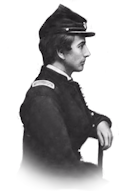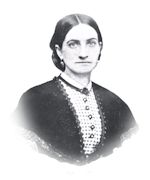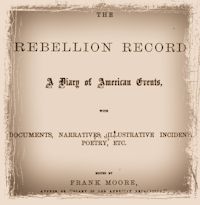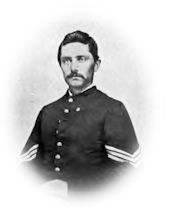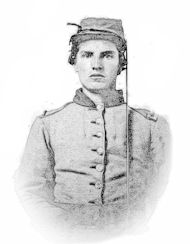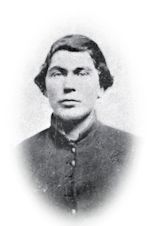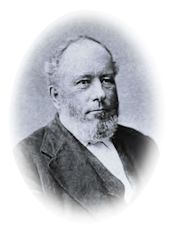October 21st. Have just returned from a little reconnoissance up the valley, to Charleston. We marched out on the morning of the 16th, weather charming, and as the country is open, and very beautiful, we anticipated a jolly time of it, but during the night, while in bivouac, it rained great guns, and made things very uncomfortable. In the morning, after passing through our picket lines, we formed in regular order, skirmishers in front, flankers on either side, advance guard with supports, batteries, etc., in superb style, strictly according to regulations. We soon came in contact with the rebel cavalry videtts, and were shelled by one of their batteries. We drove in the pickets, and our batteries gave their attention to the rebel guns. Zook and his staff rode ahead in front of the skirmish, line. Advancing through some heavy timber, we reached an open field, and on the other side of it some five hundred yards distant, drawn up in battle array, was a long line of the enemy’s cavalry, who charged across the field the moment they caught sight of us. We wheeled to the rear, and galloped for shelter behind our men. In the race I lost my watch chain, which caught in a branch and was broken off. Our men advanced, and soon the cavalry were obliged to retire about as fast as they had advanced, but I could not recover the lost chain. The advance was continued until we reached the village of Charleston, driving the enemy steadily before us, then going into bivouac for the night on the outskirts of the town. Headquarters were established in the little cemetery, said to be the place where John Brown was buried. The horses were hitched to some of the melancholy looking tombstones, and Seth made up my bed on fence rails laid across two convenient graves, which proved a grand arrangement, as it rained heavily during the night. With a rubber blanket under us and another over us we were completely weather proof, and slept like the babes in the woods. The whole detachment returned on the 18th without eliciting much information.
October 2012
October 21.—Mr. H. C. Jole of the Thirty-seventh Mississippi Regiment died to-day. The hospital is filled with men from Knoxville; they come in by the hundred, and all who are able are sent off again to other points. Many of them I never see.
News has just come that Bragg has had to abandon Kentucky, as he did not get the aid he expected from the people. This is a sad blow to us.
October 21.—A reconnoissance was this day made by a strong force of Union troops, under the command of General Geary, into Loudon County, Va. Several skirmishes took place with parties of the rebels, resulting in their retreat, leaving in the hands of the Unionists seventy-five prisoners, including a number of officers, and about thirty horses.
— President Lincoln addressed a letter to Major-General Grant, Governor Johnson, and all having military, naval, and civil authority under the United States within the State of Tennessee, recommending Thomas R. Smith, a citizen of Tennessee, who went to that State, seeking to have such of its people as desired to have peace again upon the old terms under the Constitution, to manifest such desire by electing members to the Congress of the United States, State officers, and a Senator of the United States. The President wished the parties addressed to aid Mr. Smith, and all others seeking for this object, as much as possible.—A Union meeting was held in Beaufort, N. C. Patriotic speeches were made, and resolutions indorsing President Lincoln’s proclamation liberating the slaves of rebels, were passed.
The Union army under General Schofield, left Pea Ridge, Ark., last evening, in pursuit of therebels retreating through that State. One portion of the Union army under General Schofield, taking the road toward Huntsville, and the other under General Blunt going toward Maysville, on the boundary line between Arkansas and the Indian Nation.—(Doc. 12.)
— A skirmish took place at Woodville, Tenn., between the Second Illinois cavalry, under the command of Major John J. Mudd, and a party of rebel guerrillas under Haywood, resulting in a complete rout of the latter, leaving in the hands of the Unionists forty of their number as prisoners, a wagon-load of arms, a large number of saddles, and about one hundred horses and mules.
— A fight occurred at Fort Cobb, in the Indian Territory, between a body of loyal Indians belonging to six different tribes, numbering about seven hundred, and a force of rebel Indians, of the Tongkawa tribe, under Colonel Leper, resulting in the defeat of the rebels with great slaughter. Colonel Leper, who was a white man, was killed.—Leavenworth Conservative.
October 20 — On picket. To-day twenty-seven wagons came from Harper’s Ferry through the Yankee lines and passed our post. They are wagons that the Yankees borrowed from General Jackson to convey their wounded from Harper’s Ferry to Washington, after the fight at Harper’s Ferry last month.
Monday, 20th—No news of importance. We are again drawing regular army rations, having a railroad to our base of supplies. There is little to be secured by foraging around Corinth, as the rebels’ attempt to retake the place has resulted in keeping a large force of our men here and food and feed has been almost cleaned up, with the men for a part of the time on short rations.
Monday, 20th. In the morning watered my horse and cleaned up his feet. Capt. N. told me something very acceptable from Col. Ratliffe. Read the Lorain News and Cleveland Herald. In the P. M. wrote to Fannie.
Monday, 20th.—Wagons met us this morning at 6 o’clock, with two days’ rations, ready cooked; drew one pound of bread to the man. When we arrived within four and one-half miles of Cumberland Gap, halted and waited further orders.
Corinth, Monday, Oct. 20. To-day we had to police the entire camp ground as it was reported that General Rosecrans was going to inspect camp. The ground was shoveled and swept over, but no Rosecrans came.
A Trip to Plymouth, N. C.
On the 15th of this month, the 25th, Major Pickett in command, with the 17th Massachusetts and the 10th Connecticut regiments, the whole under command of Col. Upton, embarked on steamers bound for Plymouth, on the Roanoke river which empties into the Albemarle sound at its extreme western end. On the morning of the 16th we passed Roanoke island, and our attention was attracted towards it as being the scene of our first conflict and success. We soon afterward entered the Albemarle sound, a beautiful sheet of water running east and weft, about 70 miles long with an average width of some 20 miles. It was a beautiful day, and the sail, as we slowly steamed along, was delightful, affording us a fine view of the shores. The shores were in striking contrast; the south shore is low and swampy, rising scarcely out of the water, while the north is bold, with a gently rising slope and shows many handsome farms. The scenery here is the first that has reminded us of home, and looks as though it was inhabited by a better class of people than we have yet seen.
About dusk we reach the upper end of the sound, and turning sharply to the left, enter the woods, where the overhanging branches of the tall trees seem almost to embrace each other. We are now in the Roanoke river, which is here quite narrow. In the dusk of the evening, as we grope our way along the narrow channel through the trees, the scenery is grandly wild. Some five or six miles through the woods brought us to the little town of Plymouth, situated on the left or south bank of the river. Here we drop anchor for the night, and wait until morning to learn more of our excursion.
The next morning we learned the expedition had been given up, and we steamed back down the river on our return trip, without scarcely getting a glimpse of Plymouth. On coming out into the sound we could see the little town of Edenton on the north shore, hid away in a little nook of the sound, and almost buried in trees. From our standpoint it looked like a charming little town. It is occasionally occupied by our troops and the gunboats make frequent calls there. The only setback to the pleasure of the trip down the sound was the annoyance caused the officers by the hilarity of the boys who entered into the spirit of fun and seemed to be bent on having a general good time. The officers occupied the saloon and were greatly disturbed by the noise and racket on deck over their heads. They would often send up and order the boys to keep more quiet as the noise disturbed them. The boys of course would respect their wishes, and for a time all would be quiet, but soon another party would come on deck, from some other part of the boat, and bedlam would again break loose. The officers had my commiseration; I exercised all my authority to preserve order and would willingly have done anything that lay in my power to have alleviated their sufferings, for it is not surprising that men brought up in machine shops, rolling mills, foundries and like places should be possessed of rather sensitive nerves.
We arrived back at Newbern, the morning of the 18th, having had a pleasant excursion of about 400 miles, and if we could have had our band with us the thing would have been complete. It seems the object of our visit to Plymouth was for the officers of the expedition to consult with the military and naval officers at that station in regard to the expediency of dislodging the enemy’s forces at Rainbow bluff, a point some 30 miles up the river, which prevents our boats from ascending higher up, and which they cannot shell out. At the council of officers it was decided that if we should succeed in capturing it, it would be without results, as it is of no military consequence to us, and that it would be unwise to risk men in an enterprise that would be barren in results. Hence our return to Newbern.
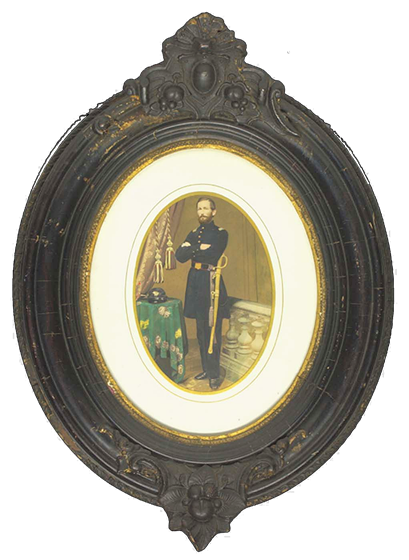
Smithsonian American Art Museum.
Museum purchase through the Smithsonian Institution Collections Acquisition Program.
salted paper print with applied color sight 6 1/2 x 4 1/2 in. (16.5 x 11.4 cm) oval.
Smithsonian American Art Museum image.
Civil War Portrait 016
